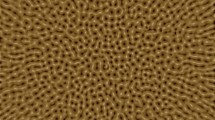Abstract
Striation defects in spin-coated thin films are a result of unfavorable capillary forces that develop due to the physical processes commonly involved in the spin-coating technique. Solvent evaporation during spinning causes depletion at the surface of the more volatile solution components while simultaneous viscous out-flow occurs providing the main source of solution thickness reduction during any typical spinning run. The composition changes in the surface layer can either stabilize or destabilize the surface with respect to convective motions within the coating solution. Destabilization (and therefore possible striation formation) happens when the surface composition changes so that a larger surface tension will develop. Thus, a careful cross-referencing of solvent volatility with surface tension effects can help establish solution conditions that will prevent this instability from arising. A plot of solvent vapor pressure (P v) versus solvent surface tension (σ) is introduced and utilized to help discuss the impact of solvent choice when making coatings via spin coating. One important result is that when desiring to deposit a coating having a surface tension of σsolid, then it is favorable to use a fully miscible solvent that has a higher surface tension (i.e., σliquid > σsolid). More complicated solution mixtures were also examined, including dual-solvent systems and water-containing systems.
Similar content being viewed by others
References
A.G. Emslie, F.T. Bonner, and C.G. Peck, J. Appl. Phys. 29, 858 (1958).
D. Meyerhofer, J. Appl. Phys. 49, 3993 (1978).
D.E. Bornside, C.W. Macosko, and L.E. Scriven, J. Imaging Technol. 13, 122 (1987).
W.W. Flack, D.S. Soong, A.T. Bell, and D.W. Hess, J. Appl. Phys. 56, 1199 (1984).
C.J. Lawrence, Phys. Fluids 31, 2786 (1988).
C.J. Lawrence, Phys. Fluids A 2, 453 (1990).
C.J. Lawrence and W. Zhou, J. Non-Newtonian Fluid Mech. 39, 137 (1991).
T. Ohara, Y. Matsumoto, and H. Ohashi, Phys. Fluids A 1, 1949 (1989).
S. Shimoji, Jpn. J. Appl. Phys. 26, L905 (1987).
S.A. Jenekhe, Ind. Eng. Chem. Fundam. 23, 425 (1984).
D.E. Haas, J.N. Quijada, S.J. Picone, and D.P. Birnie, III, Proc. SPIE 3943, 280 (2000).
B.T. Chen, Polym. Eng. Sci. 23, 399 (1983).
R. Malangone and C.D. Needham, J. Electrochem. Soc. 129, 2881 (1982).
W.J. Daughton, P. O’Hagan, and F.L. Givens, Thickness variance of spun-on Photoresist, revisited, in Kodak Microelectronics Seminar Proceedings, San Diego, CA (Kodak, Rochester, NY, 1978), PP. 15–20.
P.C. Sukanek, J. Electrochem. Soc. 138, 1712 (1991).
P.C. Sukanek, J. Imaging Technol. 11, 184 (1985).
D.E. Bornside, C.W. Macosko, and L.E. Scriven, J. Electrochem. Soc. 138, 317 (1991).
J.H. Lai, Polym. Eng. Sci. 19, 1117 (1979).
T. Ohara, Y. Matsumoto, and H. Ohashi, Phys. Fluids A 1, 1949 (1989).
D.P. Birnie, III, and Manuel Manley, Phys. Fluids 9, 870 (1997).
D.P. Birnie, III, J. Non-Cryst. Solids 218, 174 (1997).
J. Gu, M.D. Bullwinkel, and G.A. Campbell, J. Appl. Polym. Sci. 57, 717 (1995).
J. Gu, M.D. Bullwinkel, and G.A. Campbell, Polym. Eng. Sci. 36, 1019 (1996).
F. Horowitz, E. Yeatman, E. Dawnay, and A. Fardad, J. Phys. III Fr. 3, 2059 (1993).
F. Horowitz, E. Yeatman, E. Dawnay, and A. Fardad, SPIE Proc. 2288, 67 (1994).
D.P. Birnie, III, B.J.J. Zelinski, S.P. Marvel, S.M. Melpolder, and R. Roncone, Opt. Eng. 31, 2012 (1992).
D.P. Birnie, III, B.J.J. Zelinski, and D.L. Perry, Opt. Eng. 34, 1782 (1995).
D.P. Birnie, III, M. Manley, B.J.J. Zelinski, and S.M. Melpolder, Opt. Interference Coat. ‘95, Tech. Digest, TD1–TD3 (1995).
PZT coatings were made using a technique developed by R.A. Assink and R.W. Schwartz, Chem. Mat. 5, 511 (1993).
H. Benard, Rev. Gen. Sci. Pures Appl. Bull Assoc. Fr. Av. Sci. 11, 1261 (1900).
B.K. Daniels, C.R. Szmanda, M.K. Templeton, and P. Trefonas III, SPIE Proc. 631, 192 (1986).
X.M. Due, X. Orignac, and R.M. Almeida, J. Am. Ceram. Soc. 78, 2254 (1995).
M.J. Block, Nature 178, 650 (1956).
J.R.A. Pearson, J. Fluid Mech. 4, 489 (1958).
CRC Handbook of Chemistry and Physics (Chemical Rubber Co., Boca Raton, FL, 1999), edition on CDROM.
G. Vazquez, E. Alvarez, and J.M. Navaza, J. Chem. Eng. Data 40, 611 (1995).
D.E. Haas and D.P. Birnie, III, J. Mater. Sci. (2000, submitted for publication).
D.A. Nield, J. Fluid Mech. 19, 341 (1964).
A. Vidal and A. Acrivos, Ind. Eng. Chem. Fundam. 7(1), 53 (1968).
D.J. Benney, J. Math. Phys. 45, 150 (1966).
M.K. Smith, J. Fluid Mech. 217, 469 (1990).
A. Oron, S.H. Davis, and S.G. Bankoff, Rev. Mod. Phys. 69, 93 (1997).
L.E. Scriven and C.V. Sternling, Nature 187, 186 (1960).
J. Thomson, Philos. Mag. 10, 330 (1855).
D.P. Gaver and J.B. Grotberg, J. Fluid Mech. 235, 399 (1992).
J. Stichlmair and J.R. Fair, Distillation: Principles and Practices (Wiley, New York, 1998).
From example data used in the following: P.A. Rock, Chemical Thermodynamics (University Science Books, Sausalito, CA, 1983).
C.J. Brinker and G.W. Scherer, Sol-Gel Science: The Physics and Chemistry of Sol-Gel Processing (Academic Press, Boston, MA, 1990).
D.J. Taylor and D.P. Birnie, III, Chem. Mater. (2000, submitted for publication).
Author information
Authors and Affiliations
Corresponding author
Rights and permissions
About this article
Cite this article
Birnie, D.P. Rational solvent selection strategies to combat striation formation during spin coating of thin films. Journal of Materials Research 16, 1145–1154 (2001). https://doi.org/10.1557/JMR.2001.0158
Received:
Accepted:
Published:
Issue Date:
DOI: https://doi.org/10.1557/JMR.2001.0158




